Wondering why your water heater is leaking from the bottom?
If your water heater is leaking from the bottom, you must check everything carefully to find its source. First of all, you must check the temperature and pressure relief T&P valve.
The source of the leak can be at the top of your unit; the water may be running down through the body of the heater. You must check all the valves and pipes on the top of the heater also.
On electric models, the access panels should also be checked if the insulation has moisture. In this article, we will discuss the causes of the water heater leaking from the bottom and will find its fixes.
How Does Water Heater Work?
Different components of your water heater work together to heat the water. The working of some components is described below.
Thermostat
To control the temperature of a water heater inside the tank, its thermostat is responsible for it. You can set its temperature from 120 – 180 degrees Fahrenheit but most manufacturers recommend the temperature 120 -140 degrees Fahrenheit.
It will not heat your water too hot but it’s a sufficient temperature for daily household use. It will also save the risk of burning and you will be able to save your energy bills.
A thermostat is located on the tank of the water heater. It is protected by a cover plate. There are knobs or dials on it which can be moved to your desired temperature.
Dip Tube
A dip tube brings the cold water from your home’s water supply and delivers it to the tank inside from the bottom. Here the process of water heating starts. When the heating of water completes, it goes to the top of the tank.
Heat-Out Pipe
This pipe is located near the tank’s top. When heats it goes to all the facets of the house through this pipe.
Shut-Off Valve
This is used to stop the water from going into the water heater. This component is present at the top of the heater and it is located separately.
Heating Mechanism
In an electric water heater, the heating is done through heating elements inside the tank while in the gas water heater, heats the water through a burner and chimney system.
T&P Relief Valve
This tool is built into every water heater and it is used for safety. It keeps the tank’s pressure within safe limits.
Causes of Leaking Water Heater
1. Leaking Drain Valve
There is a drain valve in a water heater at the bottom of its tank. Its purpose is to empty the tank from water during the cleaning and flushing of the tank or remove the water heater.
You can identify a leaky drain valve if it’s dripping or there is moisture around it. You can notice the moisture by inserting a finger into the opening of the drain valve or checking its surrounding areas.
Turn the valve clockwise and check whether the bottom valve is closed properly. If you find that the drain valve is leaky and it does not fix by turning it clockwise, the solution is to replace it.
Replacing the Drain Valve
You will need to attach a hose to the drain outlet and keep the other end of the hose to the floor drain, to replace the drain valve. Now turn off the supply of water in the tank. Now switch on the drain valve and allow the water to run out of the tank.
Purchase a drain valve replacement from any local hard store which you can replace easily using a wrench. Take a wrench and turn the current drain valve anticlockwise to remove it.
Use Teflon tape to wrap the threads of the replacement before installing it. Now tighten the valve with your hand properly into the opening. After tightening it with your hand, take a wrench and turn it until it is perfectly tight in place.
2. Leaking T&P Relief Valve
A temperature and pressure relief valve is a device in a water heater used for protection. When the tank’s pressure gets extremely high, turning on this device will release some pressure.
Mostly the location of the T&P relief valve is at the top of the water heater; however, in most models, there is a tube attached to this valve to route the water to the floor.
The overflow tube attached to the T&P relief valve releases the excess water under the unit, so if the issue is with this valve, you will notice the leakage at the bottom of the heater.
Since the purpose of this valve is to release extra water from the tank if the pressure is too high, the thermostat should be checked. If the thermostat is set at too high a temperature, you may experience this problem.
After checking the thermostat, if the temperature is normal in it, then you can fix the leakage issue by replacing the T&P relief valve.
3. Leaking Tank
The tank of the water heater should be cleaned once a year to keep its performance efficient. When they are not cleaned periodically, the buildup of minerals makes a thick layer at the bottom of the tank.
There are different materials in this buildup such as chemicals and salts which make the inner side of the tank rusty. This corrosion leads to tank small leaks eventually.
When these small leaks occur, the pressure inside the tank pushes water from these leaks, so the size of these leaks becomes larger. This problem of leakage cannot be fixed by replacing the tank but you have to replace the whole unit.
The process of replacing is done by hiring a professional, normally but if you are a skilled person you can DIY. The electric water heater needs the disconnection of the lines attached to the plumbing system and the disconnection from the power source.
To remove the Gas water heaters, don’t forget to turn off the supply of gas to the unit and disconnect the gas line coming to the tank. When the tank of a water heater is damaged, you have to replace the whole unit.
4. Condensation
Sometimes leakage occurs due to condensation on the tank in most of the water heaters. In most cases, this problem occurs in the old models of the water heaters but it can also occur in the newer models if the thermostat is set at too high a temperature or the insulation is damaged.
To fix this, switch off the water heater for short time and let it sit idle. After turning off the unit, if the leakage doesn’t occur anymore, this means the tank is experiencing a condensation problem.
From the thermostat of the unit, lower the temperature. If still the problem exists, you may need to replace your water heater with a better model. Temporary condensation can also occur in the new models of water heaters.
When it is installed and it is filled with cold water. When the cold water is filled and yet the water has not warmed properly, condensation occurs. This is due to the difference in the temperature between the tank’s inner side and the outside air.
If You Find a Leaking Water Heater, What to do?
When you locate the leak, you must disconnect the power and supply of water to the water heater. So water damage does not occur anymore.
Read the emergency shutdown procedure sticker which is pasted on the water heater and follow accordingly. If you didn’t find any, follow the steps below:
Switch Off the Power
Electric Water Heater
From the main electrical panel, turn off the unit’s breaker. Most of the units use 240 volts dedicated circuit breaker, this means this breaker should not be used for other appliances.
Gas Water Heater
At one side of the water heater, near its bottom, find an ON/OFF dial. To switch off the unit, turn it to the OFF position.
Disconnect the Water Supply
- On the water supply inlet, notice a dial or lever.
- The location of the water supply inlet is at the top of the water heater and this is the place where water enters your unit for heating.
- So, disconnect the supply of water, turn the dial clockwise or if there is a lever, turn it to the OFF/Close position.
Next Thing to Do
You can choose to repair the leak yourself or you can hire a plumber, depending on your comfort level and the leak’s location.
If the leak has occurred in the T&P relief or drains valve, there are more chances that your unit can be repaired. But, if a leak has occurred in the tank, you will need to purchase a new water heater.
Prevent Water Heater Leaking
You can protect your water heater from leaks if you follow some guidelines. You can make your unit to work longer with regular maintenance.
To delay the start of expensive internal water heater leaks, follow these instructions:
Installing a Power-Driven Anode Rod
To prevent rust and lime scale buildup in the tank, we recommend installing a Corro-Protec-powered anode rod. Its installation is easy and it has a warranty of 20 years.
For 20 years, these anodes have been in the market and at present, they are protecting over 70,000 units throughout North America.
Before Corrosion Occurs, Install Another Magnesium Anode Rod
There is a sacrificial part inside the tank of the water heater which is called a sacrificial anode rod. To protect the interior of the tank, this rod sacrifices itself. It attracts corrosive elements inside the tank which damages the metal parts of the tank.
The anode rod works just like a magnet which attracts metal ions and minerals and destroys the tank by oxidation and corrosion. If you didn’t change the magnesium rod or don’t install the powered anode rod, your water heater will work for a few years only.
Installation of sacrificial magnesium rods is not easy to install and after installation, they work for 2 – 3 years.
Remember to Maintain Your Water Heater
If you don’t want to experience any future leaks, you should maintain your water heater regularly. Besides, flushing your unit’s tank and replacing the anode rod once a year, you should keep all the parts of the heater properly clean.
Keep the outer side, valves, and water connections clean by wiping them with a towel. So, you will never feel any damage in the performance of your heater if dirt and debris buildup doesn’t occur.
FAQs – Frequently Asked Questions
Can You Fix the Water Heaters in Case of Leaking?
If the leak is due to the components like the drain valve or T&P relief valve, it can be repaired but if the tank is leaky the solution is to change the whole water heater.
What to Do if My Water Heater is Leaky?
A leaking water heater does not need to replace the whole unit but you have to repair the leaks immediately. First, close the water and power supply to the heater. Now, detect the source of the leak.
Does a Leak Occur from the Bottom of the Water Heater?
Leaks can occur at any location of the water heater. If any leak occurs at the top of the unit, the water runs down slowly and pools at the bottom of the heater.
Is There Any Risk of Explosion of the Water Heater Due to Leak?
Water heaters rarely explode but if ever this happens, its results are highly destructive. Some signs show that the unit is near to burst.
The T&P relief valve helps us in this situation it reduces the pressure inside a highly pressurized tank.
What are the Charges to Repair a Water Heater Leak?
The price to repair a leaky water heater is around $506 and its replacement cost is between $1300 – $5500.
Final Thoughts
A water heater leaking from the bottom can be caused by any component of the unit, so the water runs down and pools at the bottom of the heater. These leaks should be repaired as soon as possible to prevent any further water damage.
Leakage that occurred due to the drain valve or T&P relief valve can be repaired but if a tank is leaking, its solution is to change the whole water heater.
To prevent your unit from further leakage, you should clean your water heater tank once a year and other parts must also be cleaned regularly. Every year replace the anode rod inside the tank.
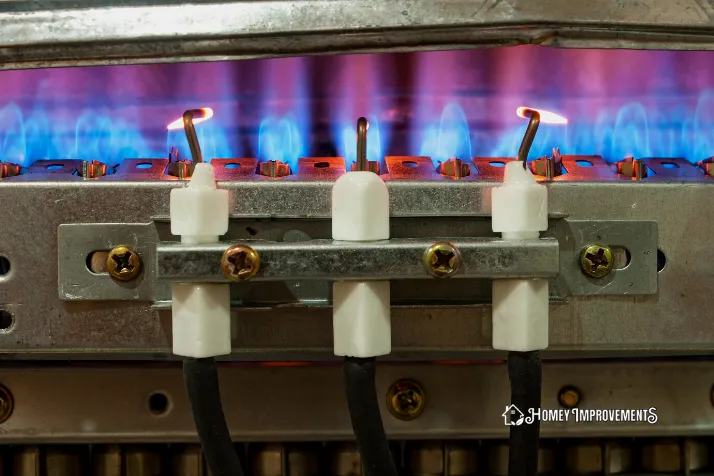

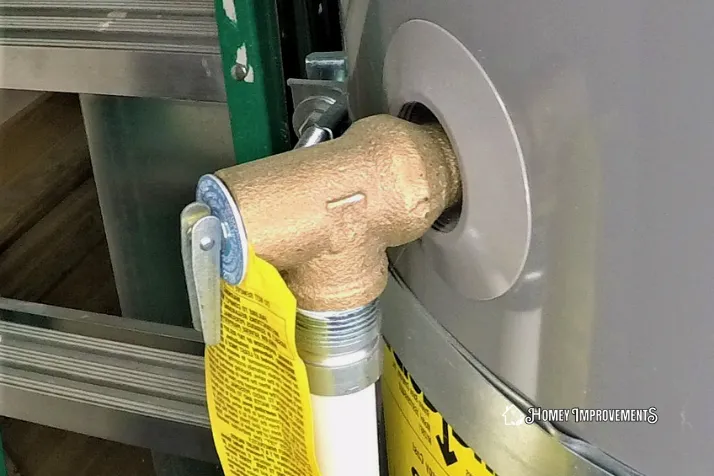
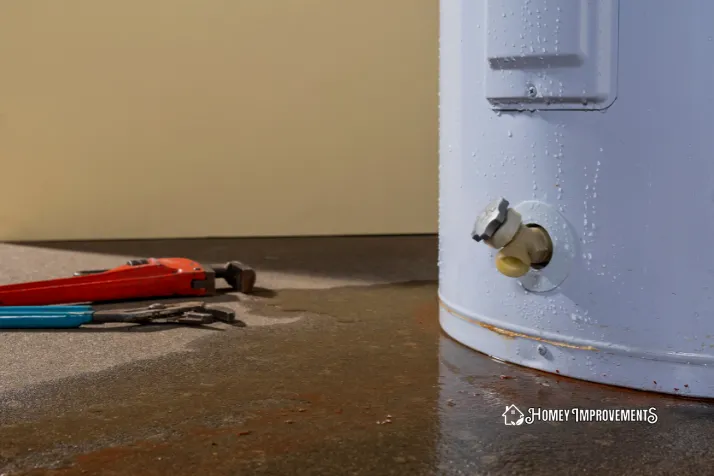
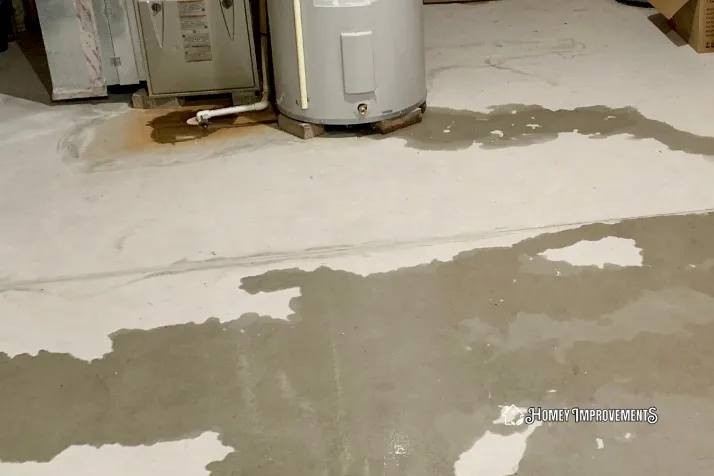
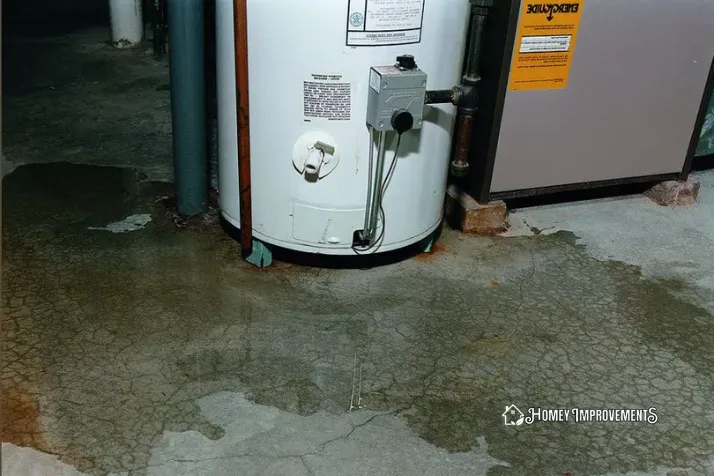
Leave a Reply